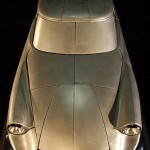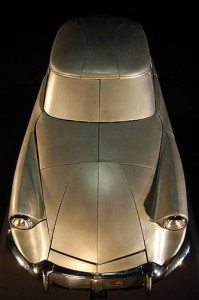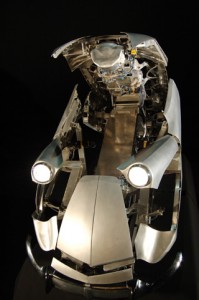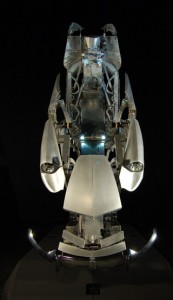
 In Zusammenarbeit mit DEAF, dem holländischen Electronic Arts Festival stellen Chico MacMurtrie und sein Team der Brooklyn’s Amorphic Robot Works die Skulptur “Totemobile” im Atrium der Den Haager Stadthalle aus.
In Zusammenarbeit mit DEAF, dem holländischen Electronic Arts Festival stellen Chico MacMurtrie und sein Team der Brooklyn’s Amorphic Robot Works die Skulptur “Totemobile” im Atrium der Den Haager Stadthalle aus.
Totemobile ist eine robotertechnisch animierte Skulptur, die sich dem Betrachter zunächst als eine lebensgetreue Kopie des Citroën DS präsentiert. Doch schon entwickelt sich die bekannte Automobil-Silhouette in ein visuell explodierendes, sich ständig umwandelndes Objekt, das sich durch verschiedene Phasen hin zu seiner finalen Form entwickelt: einem organischen, rund 20 Meter hohen Totempfahl.
Bis es seine volle Höhe erreicht, durchläuft die Installation zugleich ein Farbenspiel, inspiriert durch organisch sich entwickelnde Lebensformen und suggeriert dem Betrachter das Vorhandensein eines biologischen Organismus.
Totemobile wurde im Rahmen seiner Weltpremiere erstmals im Ausstellungsraum von Citroën auf der Champs-Élysées Nr. 42 Ende 2007 gezeigt.
Werfen wir kurz einen Blick hinter die Kulisse dieser einzigartigen Installation. Das Totemobile ist durch lineare Aktoren angetrieben und wird durch einen Allen-Bradley Rechner gesteuert, der über 100 Sensoren die Lage der einzelnen Komponenten ermittelt und den hochkomplexen Entfaltungszyklus über einen Zeitraum von rund fünfeinhalb Minuten steuert (bzw. innerhalb von rund 90 Sekunden wieder schließt). Verschiedene, unter anderem laser-kontrollierte Sicherheitssysteme sorgen für die Sicherheit möglicherweise zu nahe kommender Betrachter.
Nach rund 20 Jahren Erfahrung mit industrieller Robotik und der Nachahmung und Optimierung menschlicher Arbeitsmethodiken ist MacMurtrie’s Totemobile die erste seiner Skulpturen, die sich auf den Einsatz von Robotern im Umfeld moderner und populärer Kultur konzentriert. Aus seiner Sicht entwickelt sich das Automobil in der biologischen Vertikale, anstatt wie bisher kulturell beeinflusst und mechanisch bedingt sich ausschließlich vor und zurück zu bewegen.
 Chico MacMurtrie sagt selbst über diese Arbeit: “Ich wählte den Citroën DS, nicht weil Citroën als Sponsor auftritt, sondern weil es eine Ikone europäischer Automobile ist, und die in ihm ausgedrückte Dynamik (hydropneumatische Federung, organische Form, und mechanische Ingenieursleistung) als typisch für seine Epoche sehe. Ich wählte die DS auch, weil sie meine eigene mexikanisch-amerikanische “Low Rider” Automobilkultur stark beeinflusste. Ein “Low Rider” war Ausdruck der lateinamerikanischen Kultur… Das Tuning klassischer Automobile mit hydraulischer Aufhängung, begleitet durch ausgefallene Lackierungen, entwickete sich zu einer bedeutenden Kunstform.”
Chico MacMurtrie sagt selbst über diese Arbeit: “Ich wählte den Citroën DS, nicht weil Citroën als Sponsor auftritt, sondern weil es eine Ikone europäischer Automobile ist, und die in ihm ausgedrückte Dynamik (hydropneumatische Federung, organische Form, und mechanische Ingenieursleistung) als typisch für seine Epoche sehe. Ich wählte die DS auch, weil sie meine eigene mexikanisch-amerikanische “Low Rider” Automobilkultur stark beeinflusste. Ein “Low Rider” war Ausdruck der lateinamerikanischen Kultur… Das Tuning klassischer Automobile mit hydraulischer Aufhängung, begleitet durch ausgefallene Lackierungen, entwickete sich zu einer bedeutenden Kunstform.”
(weitere Details zur künstlerischen Interpretation unten im englischen Originaltext.)
Ausstellungsinfo unter http://todaysart.org/nl/artists/chico-macmurtrie-totemobile/.
Zur Skulptur: Totemobile, Amorphic Robot Works
Video:
Making-of Video:
—–
Citroen DS “Totemobile” @ DEAF Den Haag 2011
In collaboration with DEAF (Dutch Electronic Art Festival), Chico MacMurtrie and his team at Brooklyn’s Amorphic Robot Works will present the “Totemobile” in the Atrium of The Hague’s city hall.
Totemobile is a robotic sculpture that initially appears as a life-sized representation of the culturally iconic Citroën DS automobile. In performance, this familiar figure is visually exploded, subverted and elaborated through various levels of abstraction until it reaches its final form: an organic 20-meter-tall totem pole. Upon reaching its full height, the work blooms with light, in the form of multiple organically-inspired inflatable sculptures suggesting the final maturation of an enormous biological organism. The work has just completed a three month exhibition in Citroën’s Champs-Élysées showroom in Paris, where it enjoyed its world premiere in November 2007.
The Totemobile is powered by electric linear actuators controlled by an Allen-Bradley industrial control system. The machine is equipped with multiple emergency stops and four state-of-the-art industrial safety laser shields wired directly into the emergency stop system. This emergency system halts all machine movement, should a member of the audience get closer to the work than is safely advisable. Totemobile and its safety and control systems were Veritas inspected for public display in France.
The Allen-Bradley computer system keeps track of the machines’ every location by monitoring more than 100 sensors. These sensors assure each component follows a precise unfolding and regathering of all of the mechanical and sculptural elements in this 42-degree of freedom artwork during its five-and-a-half minute ascent and one-and-a-half minute descent.
The initial form of the robotic sculpture is deceptively simple, and belies the existence of nearly 50 interdependent machines of varying aesthetic and functional purpose. As the sculpture opens and rises, these metal and inflatable machines give voice to varying modes of mobile abstraction, which develop throughout the growth and final “blooming” of the full, 20-meter tall work.
 As the familiar structure visually decomposes into its constituent geometric parts, each part becomes a more organic version of the original, and eventually lends its decomposing body to support the life of the new organism it harbors. This automobile’s point of natural transcendence lies in its inflatable airbags: in protecting and distancing its unforgiving synthetic body from us, the inflatable provides a point of direct contact with biological frailty. This point of contact provides the “crack”, which harbors the germ of the unassailable automobile’s biological aspirations. The Citroen becomes fertile ground, which this growing inflatable seed covertly consumes, co-opts and subverts for its own needs – the new thriving body yielding where required to insure the viability of its new-found skeleton, the comfortable and utilitarian form of the Citroen DS leaving its pedestrian servitude and stretching to achieve the organic beauty and flexibility more subtly suggested in its original architecture.
As the familiar structure visually decomposes into its constituent geometric parts, each part becomes a more organic version of the original, and eventually lends its decomposing body to support the life of the new organism it harbors. This automobile’s point of natural transcendence lies in its inflatable airbags: in protecting and distancing its unforgiving synthetic body from us, the inflatable provides a point of direct contact with biological frailty. This point of contact provides the “crack”, which harbors the germ of the unassailable automobile’s biological aspirations. The Citroen becomes fertile ground, which this growing inflatable seed covertly consumes, co-opts and subverts for its own needs – the new thriving body yielding where required to insure the viability of its new-found skeleton, the comfortable and utilitarian form of the Citroen DS leaving its pedestrian servitude and stretching to achieve the organic beauty and flexibility more subtly suggested in its original architecture.
The form of the totem pole is narrative in nature. As the sculpture rises, multiple narratives unfold. In the collision, negotiation and compromises reached between the organic and the inorganic aspects of itself, narratives suggesting entropy, domination, transformation, mortality and the nature of strength are exposed.
Once the resulting half-breed reaches its full mechanical height, the inflatables finally bloom brightly into view in a moment of hybrid ecstasy, and the mechanized lid opens revealing the new growth of an organic stamen. This sign of the fully-mature organism extends further into the sky as if seeking the sun. Taking large inflating breaths, it increases in strength and size. The elaborate organic machine assimilates and conforms to its architectural confines, as if it were using the limited space the building provides to support its own growth – reminding us of a tenacious growing ivy.
After 20 years of practice using robotics, seeking to create metaphors with machines, and emulating the human condition, MacMurtrie’s Totemobile is the first of his sculptures that attempts to drastically change the direction his work has taken by engaging popular culture. Totemobile is a hybrid of an iconic symbol of popular culture and the notion of organic aspiration. It is a car that makes a biological journey upward, instead of the culturally and mechanically familiar forward and reverse. In our comfort with cars, we are invited on that journey with Totemobile, reinspiring awe in the nature that has sheltered and conveyed us, long before the appearance of the automobile.
In using robotics to explore the natural world’s growth and transformation, MacMurtrie and ARW use means which are, at first sight, vastly divergent from their subject. This apparent collision of incongruous matter highlights the unexpected appearance of an elaborate robotic device, whose sole purpose is its own living, and calls our attention back to the substance and priority of those basic biological systems of which we are a part. Systems whose fecundity and adaptability MacMurtrie’s work in robotics both emulates and envies.
Our creations in this world strive for an endurance and resonance so far achieved only by nature Herself. By moving away from the idea of longevity through unassailability, toward finding it in interconnection, interaction, and adaptability, perhaps we can express a higher form of intelligence in our own creations.
Chico MacMurtrie says: “I chose the Citroën DS, not because of Citroën’s sponsorship, but because it is an icon for European cars, and I felt that the live qualities it represented (hydraulic suspensions, organic curvature, and mechanical ingenuity) were emblematic of the time. I also chose the DS because it influenced my Mexican-American low-rider car culture. A low-rider was used by the Latin culture as a medium of expression… converting classic cars with hydraulic suspensions, utilizing elaborate paint jobs, became an art form.”
Photos courtesy Chico MacMurtrie.
Expo info at http://todaysart.org/nl/artists/chico-macmurtrie-totemobile/
Art works – more info: Totemobile, Amorphic Robot Works